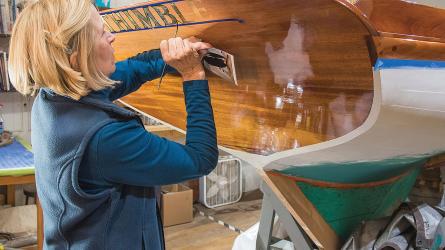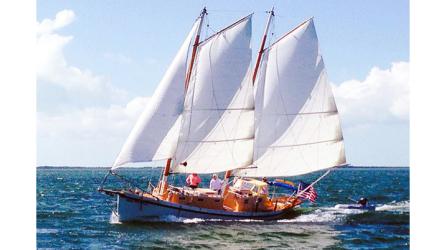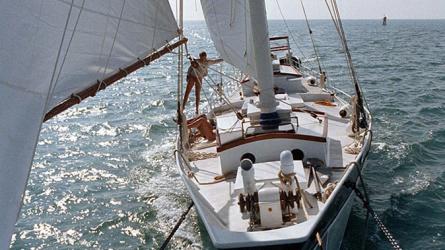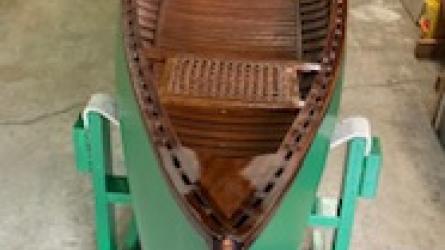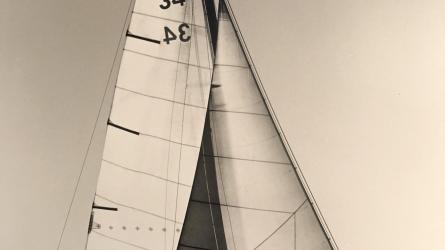How—and Why—to Build a Boat
A father’s gift to his daughter
A father’s gift to his daughter
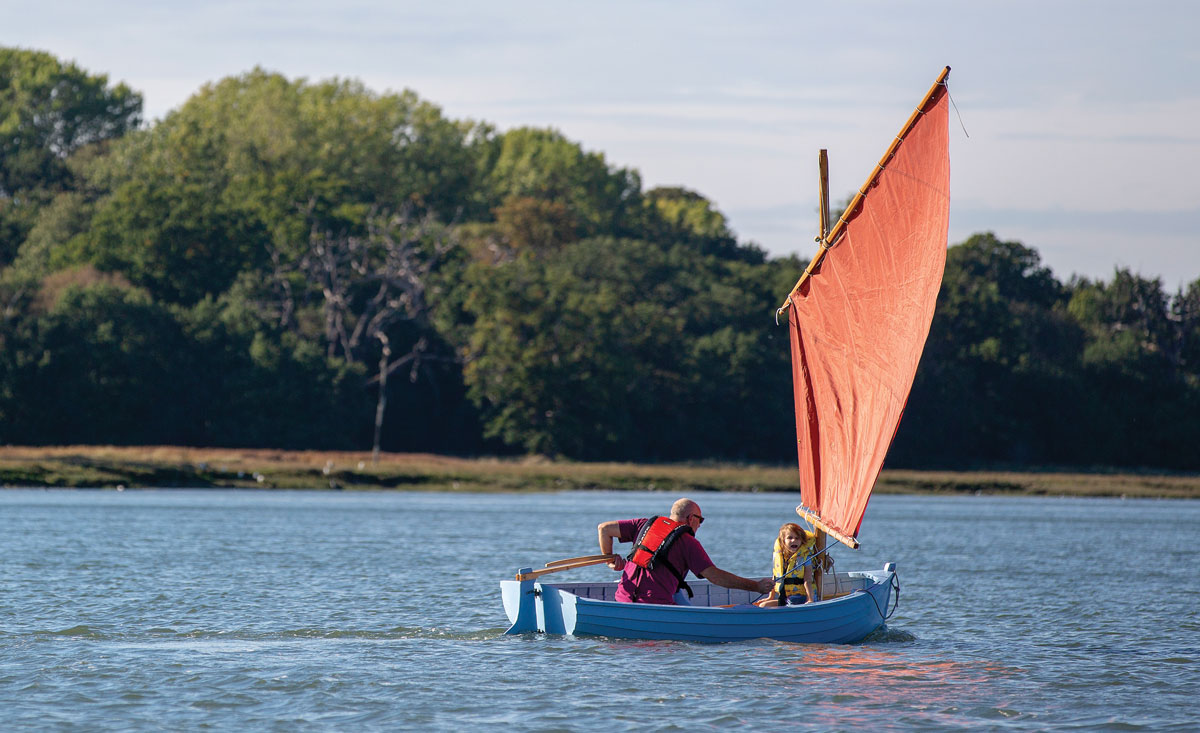
EMILY HARRIS
Author Jonathan Gornall built a traditional lapstrake boat for his young daughter, Phoebe, because he wanted “to bequeath you the sea, my darling girl, for you to love it, as I have loved it, for its beauty and its drama and the pulse-quickening promise it holds of what lies beyond the horizon….”
August 2016
Dear Phoebe,
Looking back, I suppose that at the time the decision to build you a boat must have seemed like a really terrific idea. Did I pause, even for a moment, to consider whether your daddy—a soft-handed, desk-bound modern man with few tools, limited practical abilities, and an ignominious record of DIY disaster—could possibly master the necessary skills?
More than two years on, it’s hard to remember. But I do know that in the weeks and months after you were born I found myself in a strange, unfamiliar place. Pacing the floor night after sleep-deprived night with this inexpressibly precious new life in my arms, my mental compass swung wildly from emotionally charged elation to morbid musings about your future and—as a father, for the second time, at 58—my chance of playing much of a part in it. This wasn’t an entirely unfounded concern. In February 2012, after suffering mild chest pains while running, I underwent a wholly unexpected multiple coronary artery bypass operation. So much for a lifetime of not smoking, always eating and drinking sensibly, and exercising regularly. None of it, it seems, had been sufficient to defuse the ticking time-bomb of a genetic defect that starts lining the arteries with gunk from an early age.
How, then, to reach out across time to remind you that you had a daddy who loved you unconditionally and who wanted nothing more out of what was left of his life than to equip you to make your way through yours with wisdom, courage, compassion, and imagination?
And then, out of the blue, it hit me: I would build you a boat.
The idea seemed to sum up everything I wanted to tell you about life, love, history, your story, independence, resilience, true beauty, courage, compassion, adventure…indeed, the crazed mind demanded to know, what invaluable lesson could possibly not be learnt in such a classroom?
I want to bequeath you the sea, my darling girl, for you to love it, as I have loved it, for its beauty and its drama and the pulse-quickening promise it holds of what lies beyond the horizon—and what better way to introduce you to this special, contemplative place than through the gift of a boat? Not a boat that can be bought, or mass-produced, or made out of plastic, but a traditional wooden boat that your hopelessly ill-equipped daddy has made just for you, in defiance of his lack of ability, in an age when so few of us can make anything.
It will be both a gift and, for me and for you, a life lesson—a thing of inherent beauty that, in having no real purpose, has many.
I hope that in its graceful lines and timbers, infused with love, sweat and, quite probably, more than a little of your daddy’s blood, you might divine a set of ideals and a promise of possibilities that will help you to navigate a fair but bold course through life, respectful of the achievements of the past, skeptical of the promises of the present, and excited by the possibilities of the future.
If your particular existential crisis urges you to climb a mountain, the chances are you’ll head for Everest. Likewise, if it’s long-distance solo rowing that floats your boat, you’ll probably set course on the Atlantic. And, should you decide to defy a complete lack of skills, and aptitude, to build a traditional wooden boat, then lapstrake construction really is your only option.
Because here’s the thing about lapstrake: there is no boatbuilding technique so respectably ancient, so historically resonant, so seductively beautiful, and so bloody difficult.
On paper it doesn’t sound too bad. Lapstrake (also known as clinker or clenched lap depending where in the world you live) is the process of building up the hull of a boat with a series of strakes, a strake being composed of one or more planks joined together end to end. Each strake is slightly overlapped by the one above and fastened to it with copper nails driven through the overlap at regular intervals. On the inside of the overlap the ends of the nails are hammered down over a circular washer, or rove, which pulls the planks tightly together.
Ta-dah! Sounds pretty easy, right? But you and I—as of September 2016, at least—have absolutely no idea. None at all.
As I kid myself I’m weighing the pros and cons of tackling lapstrake planking, in truth all I am doing is mooning over the sheer beauty and romance of the thing. And such romance. You might not even know the words “clinker” or “lapstrake,” but you will instinctively recognize the boat that’s built this way, because from the east coast of England to the east coast of America it’s the one drawn up on the beach that turns your head, makes you reach for your camera, and wish you could paint—or build boats.
Lapstrake is not just a pretty face. Over time, most technology either evolves or vanishes altogether as improvements are made. The spear gave way to the bow and arrow, which in turn was replaced by the crossbow, which yielded to the first crude firearm, and so on. Today, barely a month goes by when the microchip, the engine at the heart of our digital age, is not improved.
But, aside from local variations and the occasional tweak here and there, lapstrake boatbuilding has evolved barely at all since it emerged from the mists of northern European mythology 2,000 years ago—which, to anyone of an even faintly romantic disposition, surely suggests at the very least something rather magical at work.
My chosen design is the Nottage Dinghy, designed by Fabian Bush. It consists of 20 overlapping strakes, each of which will be fixed to its neighbor by 20 riveted copper nails, set at intervals of 5½″ (140mm). To this total of 400 rivets will be added 400 more, longer so they can be driven through the strake overlaps and the vertical frames that will be steamed and bent into place once the hull is complete. When all is done, each strake will be held to the next by a row of 40 rivets. The integrity of the hull will ultimately depend upon how well the lower edge of each strake conforms to the upper edge of its overlapped neighbor—and on the correct placement of 800 rivets.
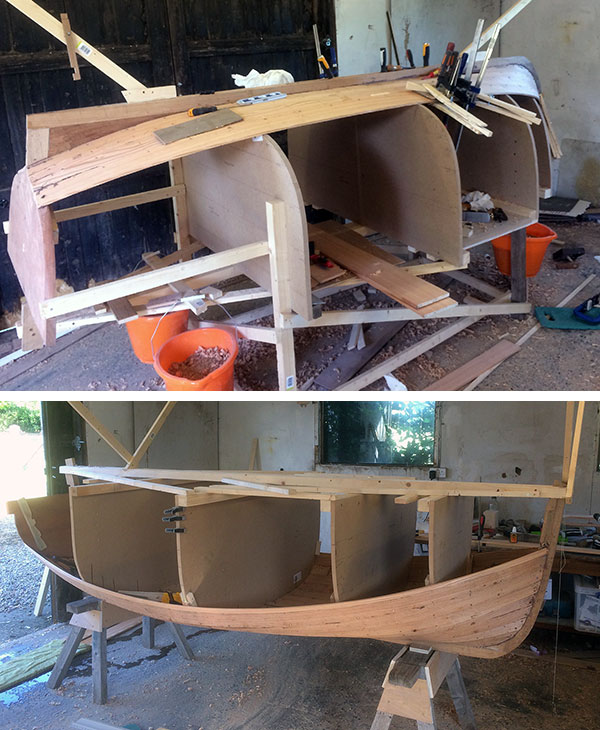
JONATHAN GORNALL
“[F]rom the beginning I suspected that if any part of the process of building this boat was going to tip me over the edge, it would be the planking, and there’s no doubt that up until now each strake has been a complete swine, extracting blood, sweat, and tears as the price of its ultimate, reluctant cooperation.”
Late one afternoon, early in the project, I put the nearly complete stem in my backpack and cycle it home from my workshop to show to Phoebe and my wife, Kate. The ride home, along lanes cutting through fields and small stands of trees, is a joy. It’s still only mid-February, but after frosty starts and sub-zero temperatures in January—the coldest the county has seen for more than four years—the sun has returned, determined to kick-start spring.
When I arrive home, Phoebe seems unimpressed, although, as I have to keep reminding myself, she is still not quite three years old. Nevertheless, she shows an intelligent interest in the stem, for about as long as any toddler can be expected to.
“What is it, Daddy?” she asks, reaching up tentatively to touch it as I pull it out of the backpack.
“It’s the front bit of your boat,” I say. “It’s called the stem. What do you think?”
She stares hard at the stem for a moment, and finally announces, laughing, “It’s ridickerous.” Phoebe’s Tigger-inspired approximation of “ridiculous” is usually deployed, we’ve noticed, when she’s put on the spot over something she doesn’t quite understand. But I know exactly what she means. The whole thing is ridickerous.
Kate takes the stem from me and looks at it closely, turning it over and squinting at details, like an antiquarian examining a rare piece. I’m braced for a quip but disarmingly all she says is, “You know, this really is quite impressive. Well done, you.”
“Um, thanks,” I say, retrieving the artifact and flopping down on the sofa with it on my lap. “There’s still quite a bit to do,” I add, unnecessarily.
Kate laughs. “Yes, I can see that,” she says.
After a month of sawing, planing, chiseling, blundering, hacking, gluing, and bleeding, I have finally completed the all-important, six-part, three-dimensional jigsaw puzzle that is the centerline of the boat. Keel, deadwood, hog, sternpost, stem, stem knee…of these six components, a month ago I’d have recognized the name and grasped the function of only one, the keel. Now I see and understand them all in my dreams.
And there it is, a thing of beauty and not a little wonder, six parts become one. Remarkably, I have made something with my own hands. And now here it is, sitting on the workbench like a challenging work of art. With perfect timing, Kate pulls up outside the open workshop door and lowers Phoebe’s window.
“Hello Daddy,” Phoebe calls out. “Where’s my boat?”
I open her door and unbuckle her harness. “Would you like to come in and see it?”
“Yes!” she shouts, and she’s off, leaping out of the car and storming into the shed. Kate’s hot on her heels, muttering something about a health-and-safety nightmare. Various lethally sharp tools lie here and there, well within reach, and the floor around the bandsaw is littered with sharp, jagged-edged slices of timber sawn off the keel. I haven’t really thought this through. Phoebe is at the workbench now, trying to figure out how to crush one of her hands in the vise.
“Darling,” I say, trying to divert her attention to the centerline construction towering above her. “Look: I’ve finished the middle of your boat.”
She puts the self-harming on hold, while retaining her grip on the arm of the vise, and looks at the centerline. She frowns skeptically.
“That’s not a boat,” she says.
I point to the stem, which I’d brought home to show her. “Well, it’s going to be. Remember this bit?”
Suddenly, her eyes widen and she lets go of the vise. “Look, look!” she shouts, pointing. I smile; she gets it.
But no. She’s not pointing at the centerline, but past it. “A horsey!” There is indeed a horsey, one of two that live in the field at the back of the shed, and it’s peering in over the fence and through the window. Phoebe, pursued closely by mummy, heads for the door at speed to make its acquaintance.
Several days pass before all four molds are complete. Fitting them to the centerline demands complete accuracy, and takes the best part of another day. Then there is one more job before planking can begin: transferring the life-sized half-drawing of the transom from the plans to an intimidatingly beautiful chunk of mahogany.
There is, of course, no planking in place yet. But with the transom screwed to the sternpost and all four molds squared up and on station, it’s possible to squint through narrowed eyes and all but see the boat that this growing collection of parts is destined to be.
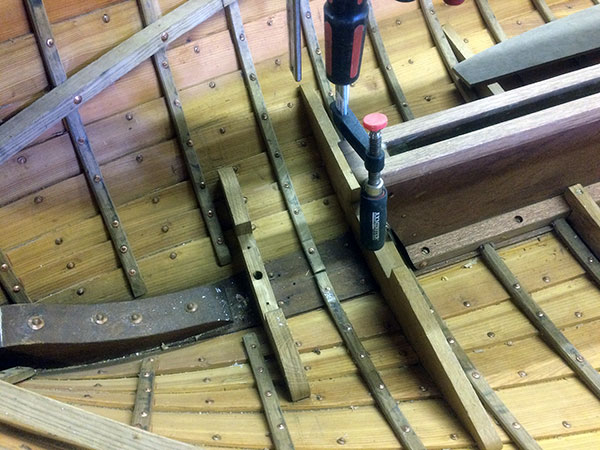
JONATHAN GORNALL
“With the frames fitted, it was hard to resist the feeling that Phoebe’s boat was finished. It wasn’t, of course. There was still a great deal of relatively challenging work to be done.”
My first plank goes on, eventually, in a blur of steam burns, curses, general panic, and clumsy fumbling. It’s only a rough fit at this stage, to introduce the plank to the new shape that’s required of it. Once it cools down and “sets,” the clamps can come off again and the fine detail work can begin.
It will take me six days to get the garboard plank right—not finished, just ready to be fixed in place. Six days. In the process, it will go on and come off the boat maybe 30 times or more. I lose count. Or, rather, I stop counting because it’s just plain demoralizing.
With each strake that goes on, access to the inside of the boat becomes more restricted and it gets harder and harder to hammer down the roves accurately on the nails. Instead of speeding up, as I imagined I might with practice, I actually seem to be slowing down.
Boatbuilding, with its series of leaps of faith and hills and valleys of elation and savage despondency, is a particularly grueling solitary activity. Striking up conversations with uncooperative tools or intransigent pieces of timber seems, counterintuitively, to be a functional way of retaining a degree of sanity. Right from the beginning I suspected that if any part of the process of building this boat was going to tip me over the edge, it would be the planking, and there’s no doubt that up until now each strake has been a complete swine, extracting blood, sweat, and tears as the price of its ultimate, reluctant cooperation.
Each plank, from the first to the last, was an unmitigated struggle. Although I came to sort of understand what I was doing, there was never a lightbulb moment, a breakthrough in complete comprehension. I made every possible mistake over and over again. I stumbled repeatedly into every potential pitfall.
But, as I contemplate the half-finished, doubtless flawed but nevertheless utterly and surprisingly beautiful little boat that is emerging despite my worst efforts, I realize that something else is going on—something that has crept up on me wholly unexpectedly.
I might not have got any better, or much faster, or appreciably more confident in what I’m doing. Most certainly I am still making mistakes and, as Fabian assured me it would be, planking is a complete and utter bloody slog. But, dammit, I’m enjoying it.
Now the planking is finally completed and I face the final substantial hurdle: fitting the 38 oak frames in Phoebe’s boat. The Nottage plan calls for 19 equally spaced pairs of frames, each to run from the top edge of the sheerstrake down to the center of the boat. Then, the tip of each one of the copper nails that will be inserted into holes in the planks and then driven through the frames must be subtly blunted with a few gentle taps of a hammer.
With the frames fitted, it was hard to resist the feeling that Phoebe’s boat was finished. It wasn’t, of course. There was still a great deal of relatively challenging work to be done—the “basic carpentry,” as Fabian had put it, somewhat dismissively, of seats, centerboard trunk, floorboards, and such, to say nothing of the rudder, tiller, mast, and spars, and, when all else was done, painting it.
But there was no avoiding the conclusion that I had built a boat.
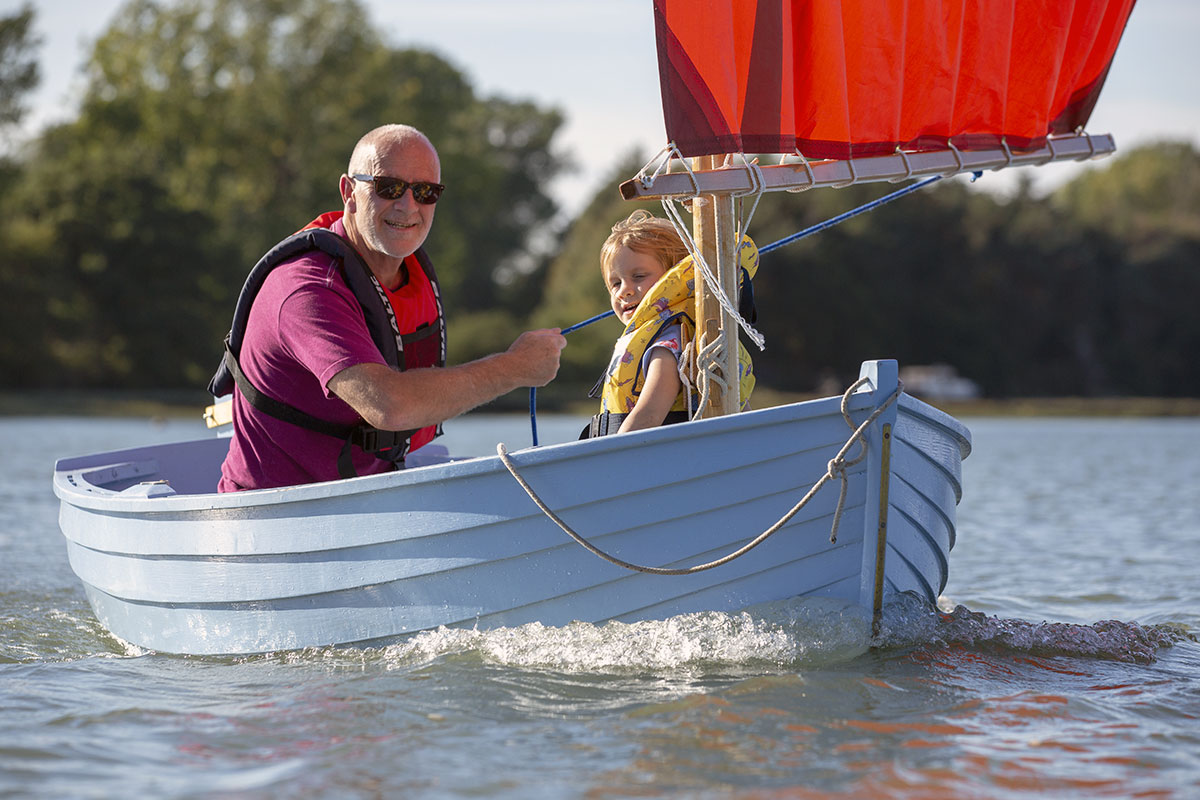
EMILY HARRIS
”SWIFT is a charming collaboration of imperfections…. But I don’t mind. I’m as proud of those mistakes as a warrior of his battle scars.”
April, 2018
Dear Phoebe,
Even out on the open water of Buttermans Bay, the light breeze barely troubled the skull and crossbones at the masthead. Here, in the lee of the wooded cliff, it has all but petered out, so I lower the tan lugsail and reach for the oars. But SWIFT, as if determined to find her own way home, requires no mortal assistance and rides the last of the flood back towards Pin Mill unaided.
The riverside village comes into view and that’s when I catch sight of you, playing at the distant water’s edge with mummy.
In three weeks, you will be four years old. Sometimes it feels as though you have always been in my life—the sheer vitality of your all-consuming presence overshadows all that went before. At other times, such as now, the simple, startling fact of your existence takes me utterly by surprise.
On this bleak, uninviting Easter Sunday, few people have ventured down to Pin Mill, which suits me and my last-minute decision to launch SWIFT this morning just fine. No one said there had to be multiple witnesses.
A clinker-hulled wooden boat can be expected to let in water here and there before its planks swell a little. But, to my surprise, the bilge was all but dry. This seemed barely credible. I was painfully aware of the many cock-ups I had made, the fact that not one strake had gone on entirely to my satisfaction, that far too many rivets had been hammered home more in hope than in expectation of a proper fit.
This could mean one of only two things. Either the whole ancient clinker process was a lot more forgiving than its champions let on. Or, perhaps us denizens of the modern, digital world aren’t quite as helpless and impractical as we fear.
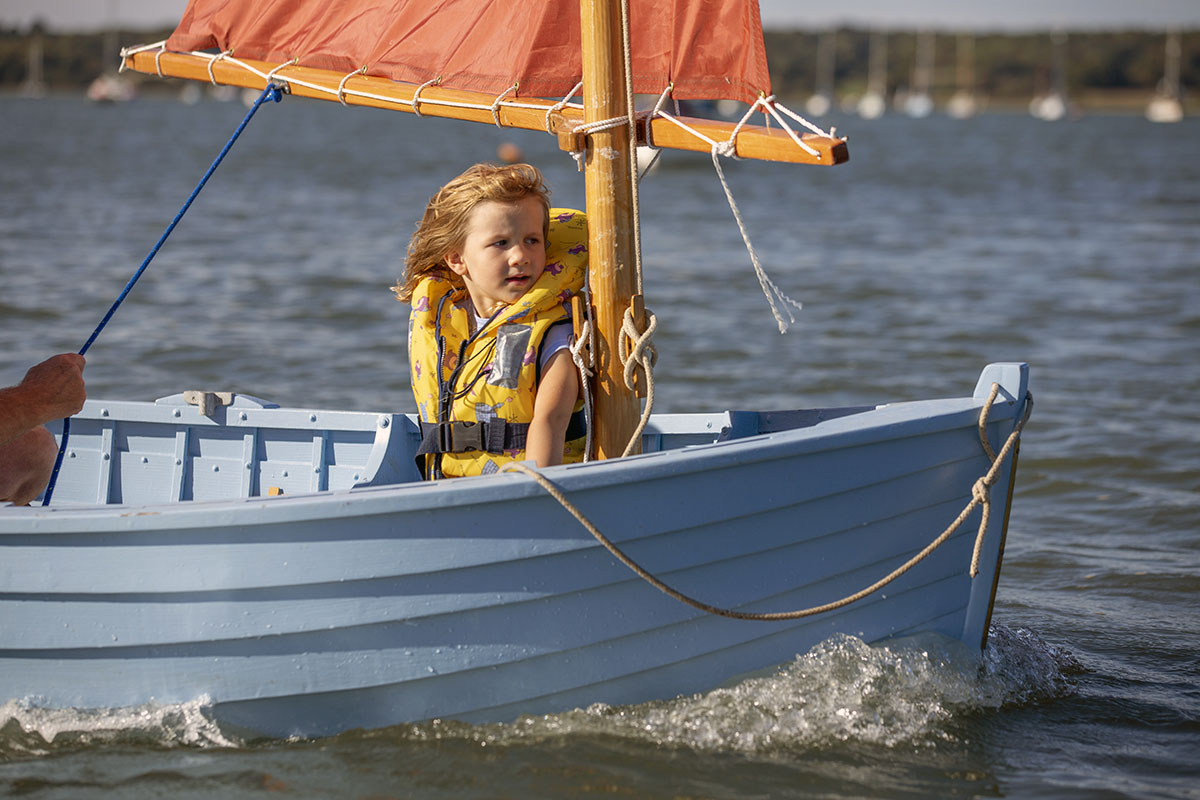
EMILY HARRIS
“I hope that in its graceful lines and timbers, infused with love, sweat and, quite probably, more than a little of your daddy’s blood, you might divine a set of ideals and a promise of possibilities that will help you to navigate a fair but bold course through life….”
Of course, I’m not fooling myself—or anyone else. I know that while I may have built a boat, I am by no stretch of the imagination a boatbuilder. SWIFT is a charming collaboration of imperfections, as anyone even faintly au fait with the art and craft of boatbuilding could tell at a glance.
But I don’t mind. I’m as proud of those mistakes as a warrior of his battle scars. They attest to the fact that this boat—this boat that actually floats, for heaven’s sake—came into being despite all the odds. It is a symbol of the triumph of determination over ignorance and incompetence.
Neither you nor mummy has spotted us yet. You aren’t expecting to. As far as you know, daddy is in the shed, working on your boat, as he has been most weekends this past year.
One hundred yards to go. SWIFT rows well.
In a black-and-white photograph taken at this very spot during the summer of 1908, a young girl in a stiff white dress stands as close to the water’s edge as she dares to go without risking the ruin of her best pair of shoes. Two boys, meanwhile, about her age, are up to their knees in the water, having great fun and apparently doing their best to make off with a small boat tethered to a wooden post. The girl, buttoned up in her Sunday best, can only look on enviously.
I glance over my shoulder at you, beginning to explore your unlimited world in the very spot where, a century ago, another little girl was discovering only the limitations of hers. You have timed your arrival in this world well.
Mummy’s pointing now, trying to draw your attention away from whatever it is you’ve discovered in the mud, and you look up just as SWIFT’s keel glides to a halt a few yards away. It takes a moment, but then recognition and wonder flood in and your face breaks into a broad smile.
“Daddy!” you shout, splashing through the water towards me. “Is that my boat?”
It is, my captain.
You stand on the shore of the unsailed sea that is your life. May you sail it with courage, compassion, grace, and joy. 
Jonathan Gornall is a freelance British journalist specializing in health. He was formerly with The Times, has lived and worked in the Middle East, and now lives in East Anglia, England, with his wife and daughter.
This article is excerpted and adapted from the author’s book How to Build a Boat, which was recently released by Simon & Schuster in the U.K., Scribner in the United States, Seix Barral in Spain, and DeA Planeta Libri in Italy.
